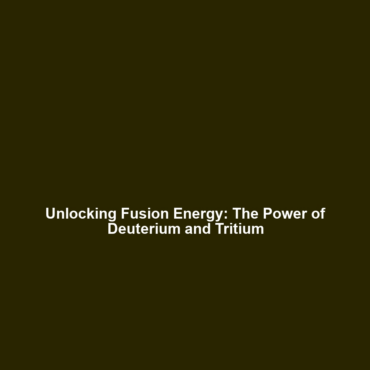Inertial Confinement Fusion: A Key Process in Fusion Energy
Introduction
Inertial Confinement Fusion (ICF) represents a cutting-edge approach in the quest for sustainable fusion energy. This advanced process employs powerful lasers or particle beams to compress a small fuel pellet, creating the extremely high temperatures and pressures required to initiate nuclear fusion. As the scientific community strives for clean energy solutions, ICF stands as a pivotal mechanism in the broader sphere of fusion research, promising potential benefits that could revolutionize energy generation while mitigating climate change.
Key Concepts
Understanding ICF
ICF relies on the principles of physics that govern nuclear reactions. The core idea is to rapidly compress a deuterium-tritium (D-T) fuel pellet, causing the nuclei to collide at speeds sufficient to overcome electrostatic repulsion and achieve fusion. The critical aspects of this process include:
- High Energy Density: ICF generates substantial energy per reaction, making it a potent energy source.
- Temperature and Pressure: ICF requires achieving millions of degrees Celsius and immense pressure, conditions found typically in stellar cores.
- Laser Systems: Powerful laser systems, such as those at the National Ignition Facility (NIF), are instrumental in delivering the massive energy needed for compression.
Applications and Real-World Uses
The applications of ICF are primarily focused on its potential role in fusion energy. Some noteworthy uses include:
- Energy Generation: Developing viable fusion power plants that could provide consistent and clean energy.
- Nuclear Weapons Research: Understanding fusion processes enhances national security through the stewardship of existing nuclear arsenals.
- Plasma Physics Research: ICF experiments contribute to broader scientific knowledge regarding high-energy-density physics.
Current Challenges
Despite its promise, the challenges of Inertial Confinement Fusion remain significant:
- Cost: The technological infrastructure required for ICF is expensive to build and maintain.
- Efficiency: Current methods struggle to achieve a net gain in energy output.
- Scalability: Transitioning from experimental setups to commercial power plants poses several technical hurdles.
Future Research and Innovations
Future research in ICF aims at overcoming its current limitations and enhancing its feasibility as a mainstream energy source. Innovations may include:
- Advanced Laser Technologies: Development of next-generation laser systems that offer improved efficiency and energy output.
- Hybrid Fusion Systems: Combining ICF with Magnetic Confinement Fusion (MCF) to potentially achieve greater overall efficiency.
- Material Science Advances: Research on new materials capable of withstanding the extreme conditions in ICF reactors.
Conclusion
Inertial Confinement Fusion stands at the forefront of fusion energy research, offering a pathway toward sustainable and expansive energy solutions. Understanding how ICF works and its challenges provides insight into the future of energy generation. Continued investment and research will be critical in addressing current limitations and unlocking the vast potential of fusion. For further reading on related topics, explore our articles on Fusion Technology and Nuclear Energy Applications.









